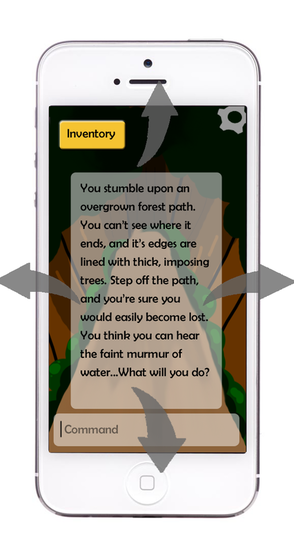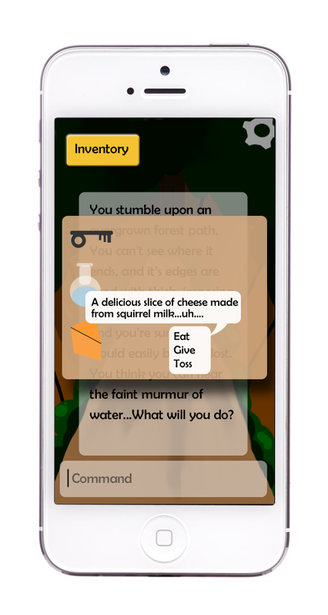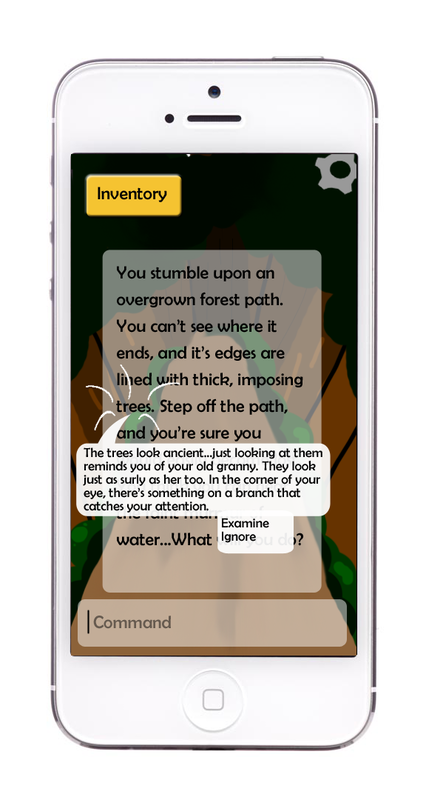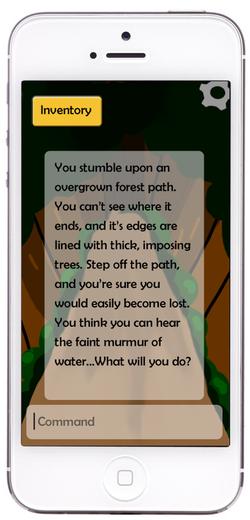 Example of what a typical scene might look like
Example of what a typical scene might look like
One of my future goals that I am excited to accomplish hopefully in the near future is to create an interactive fiction game for iOS and Android. I will enhance the IF experience by adding in art, sound, music, narration, and interactive game-play in the touch environment. As far as I know, an implementation of this kind has never been done.
Just as in typical interactive fiction, the overall narrative will be told through text. However, the touch environment will provide new features that will: make the story easier to navigate through; introduce interactive game-play with the story; and immerse the player in the game.
You will be able to swipe in the direction you want to go in or use the command line to type the action. Similarly, you will be able to press the inventory button to bring up a graphical interface of the inventory or you can again, use the command line. In the inventory, you can tap an item to bring up a description, where you picked it up, etc. If the item has actions that can be performed, those will appear.
You will also be able to tap keywords on the screen to bring up a description and any possible actions. Again, this feature can also be accessed through the command line.
All touch features will be able to be changed through the settings, so if you wish for the game to be a typical interactive fiction or you want some of the features disabled, you can do so. There will be an option for the text to be narrated by a male or female voice. Music, art, and sound features will also be able to be changed or toggled off.
A thought that I had while designing this was whether it preserved the raw imagination that interactive fiction often provokes. IF is normally text, allowing the player to interpret the words and scenes as he or she sees fit. By adding in art, music, and sound, it automatically presents the scene and atmosphere to the player, removing part of the imagination process. My concluding thought was for the art to be generic or simple enough so that the player can fill in the voids. For example, if the scene is a hallway, the background art will be a plain hallway, but the text might explain how there are dozens of portraits of dogs playing cards. This leaves some of the scene up to the player to imagine.
Just as in typical interactive fiction, the overall narrative will be told through text. However, the touch environment will provide new features that will: make the story easier to navigate through; introduce interactive game-play with the story; and immerse the player in the game.
You will be able to swipe in the direction you want to go in or use the command line to type the action. Similarly, you will be able to press the inventory button to bring up a graphical interface of the inventory or you can again, use the command line. In the inventory, you can tap an item to bring up a description, where you picked it up, etc. If the item has actions that can be performed, those will appear.
You will also be able to tap keywords on the screen to bring up a description and any possible actions. Again, this feature can also be accessed through the command line.
All touch features will be able to be changed through the settings, so if you wish for the game to be a typical interactive fiction or you want some of the features disabled, you can do so. There will be an option for the text to be narrated by a male or female voice. Music, art, and sound features will also be able to be changed or toggled off.
A thought that I had while designing this was whether it preserved the raw imagination that interactive fiction often provokes. IF is normally text, allowing the player to interpret the words and scenes as he or she sees fit. By adding in art, music, and sound, it automatically presents the scene and atmosphere to the player, removing part of the imagination process. My concluding thought was for the art to be generic or simple enough so that the player can fill in the voids. For example, if the scene is a hallway, the background art will be a plain hallway, but the text might explain how there are dozens of portraits of dogs playing cards. This leaves some of the scene up to the player to imagine.
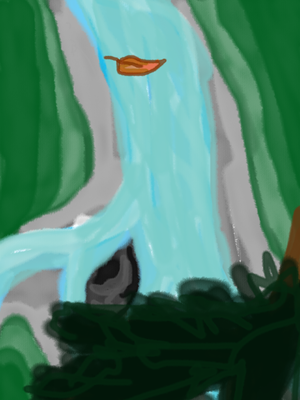 Top view of scene. Tilt to move the leaf, and
Top view of scene. Tilt to move the leaf, andsome of the path is shrouded by the tree
- The initial scene is a leaf, falling off a branch in late Autumn; it lands into a flowing river. You play as the leaf drifting down currents, and you can control what direction the leaf heads in, but ultimately you are swept up by events and the current. The purpose is to demonstrate the life mentality of "go with the flow". There would be different perspectives, so maybe initially you are looking from above and you can see certain paths but others are obscured by trees. You don't know where the paths will lead: maybe a waterfall, a pool, or straight into a rock. Events could happen such as: storms; more leaves could come and join your journey down stream; the leaves could clog the pathway in front; frogs or animals could come and disturb the flow; and you could become stuck in places such as a pool or rock. It would be best on a platform that supports tilt features, such as PS3, iOS, Android, etc. There wouldn't be a score or so much as an "ultimate" purpose to win the game, but mostly a calming, meditative game to promote self-reflection.
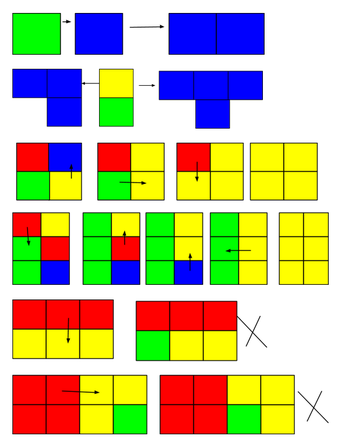 Example of possible moves and solutions
Example of possible moves and solutions
- You have a screen full of mixed up colored boxes or blocks, and you slide the boxes into one another until the whole screen is one color. The first box color is changed to the second box color when they collide-this also joins the boxes together. The point of the game is: with a limited amount of moves to cover the entire screen in one color. Each level will have a specific set of rules. For instance, red can't collide into green, you can't collide sets of 3, etc.
You can move a single box into another box or collection of boxes to change it. If you move a collection of boxes into another collection of boxes, then the height or width (depending on what direction you are going) has to be the same. This is shown in the last two diagrams.
It's supposed to be a fun puzzle game to help pass the time or to be relaxing.
- A princess that gets captured by a neighboring kingdom, and while a knight is sent to save her, she instead: breaks out; fights off enemies; uncovers that her father actually conspired against her and planned her kidnapping; and rescues her own kingdom from his tyranny. Instead of relying on other people to save her, she decides to save herself.
- A horror game that takes in noise feedback to determine the monster's move. For example, if you are screaming then the monster will find you and kill you. If you are quiet, then it will pass you by. This mechanic could be similar to the hiding method in Amnesia: The Dark Descent, where the player has to hide from monsters and has no fighting capability. The game would have to be scary enough to provoke fear, anxiety, and vocal reaction. Thus, when the player is forced to be quiet, it immerses the player in the scene and they feel like they are actually experiencing the event.
